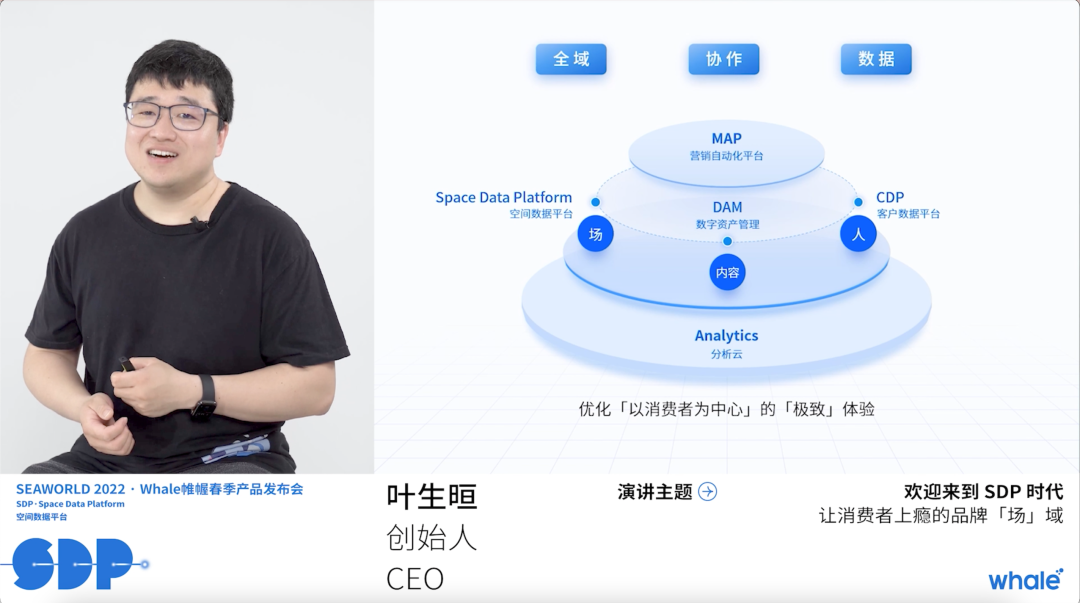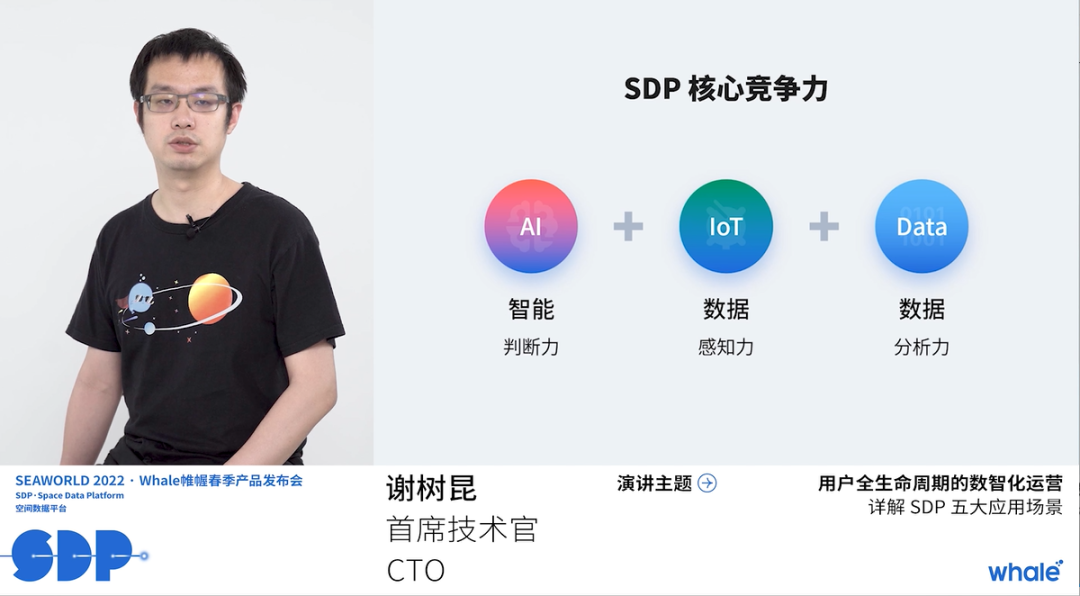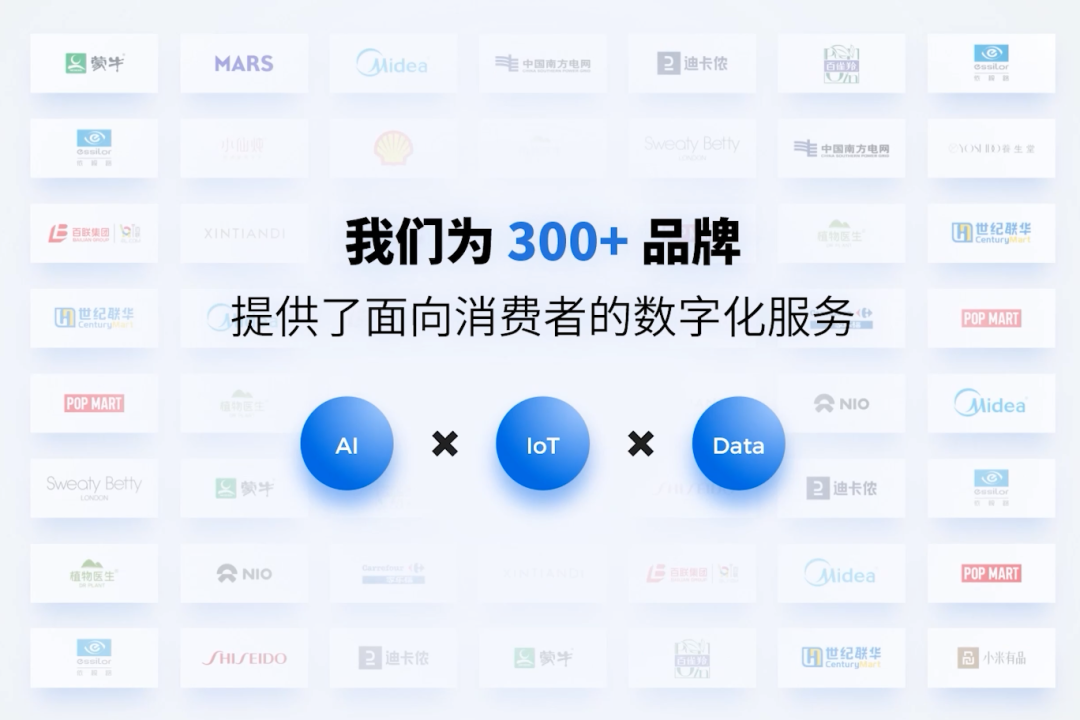Morketing Interview | Is the last mile of MarTech good field data management?
On May 13, Whale held the 2022 SEAWORLD Spring Online Product Launch. At the event, Whale announced for the first time a spatial data solution dedicated to providing "people-content-field" integration for brand stores, "SDP - Space Data Platform".

The official description is "a new solution based on data analysis of commercial space field" and "deeply help brands to promote the digitalization process within the integrated online and offline 'field'".
For SDP, Whale has a very attractive slogan: "Create a new brand space that makes consumers 'addicted'".
The slogan is loud and clear, but how exactly does SDP help brand owners build a new and exclusive space? How can this space, which is based on a data platform, interact with consumers? How does SDP help brands become sticky and "addictive" to consumers?
For this reason, Morketing invited Mr. Ye Shengyun, Founder & CEO of Whale, and Mr. Xie Shukun, CTO of Whale, to discuss the uses and advantages of SDP, and the significance of the product in the era of Web3.0.
01
Why do brands need to build field data management capabilities?
The emergence and iterations of MarTech products are ultimately designed to help brand owners solve the troubles they encounter in their business management and marketing processes.
In the post-epidemic era, brand owners in any track are feeling the sluggish pace of the market and the diminishing enthusiasm of consumers. Not only that, on the online side, there are more and more brand contacts and consumers' purchase channels are more and more scattered, resulting in complex and diverse consumer purchase journeys. It has become a difficult and important task for brand owners to control the time nodes of online placement, attraction and pushing new work and make full use of every marketing activity during the special period of calm market sentiment; offline, every consumer's WeChat has Many consumers have "XX brand XX store membership groups" in their WeChat, but they are invariably in the no-disturb mode, so the so-called private domain operation can do little to build brand stickiness and promote repurchase.
Thinking in the context of the development of MarTech capabilities, the above reality actually points to a problem: in the past, brand owners have gained the opportunity to reach consumers in a more high-frequency and decentralized manner with the help of digital marketing; at this stage, brand owners have to learn to use these touchpoints more effectively and with half the effort. At this point, brand owners need to master the ability to scientifically and effectively manage the whole field from "online" to "offline".
Whale's initial goal in establishing SDP is to build this kind of domain management capability. In the missing "people, goods and field", there are many MarTech platforms that help brands manage "people" and "goods", but the level of MarTech that helps brands do "field" has not kept up," Ye Shengxuan told Morketing.
"Today, user journeys are switching between different scenarios and are very complex. For example, if I buy a pair of Nike shoes, I may initially see them in an offline store while shopping, I open xiaohongshu to read netizen reviews during the trying on process, and then I go home and see the same model in my circle of friends, and finally my purchase happens on Poizon ...... between consumers and products, exactly How does the interaction occur in different fields? For brands, they need to master more diverse insight and understanding." The brand needs to master more insight and understanding," said Ye Shengxuan.

The SDP is able to realize the data capture of different platforms online, taking into account the data capture in the brand's offline stores, and then analyze and review this information to optimize the next online and offline marketing behavior.
It can be said that the emergence of SDP is actually an inevitable outcome of the development of digital marketing so far. For brand owners, this can visualize the "invisible data" hidden in the online and offline areas, which can be used to improve management and performance; for consumers, they can be better served and have a better experience throughout the purchase journey.
02
The three main advantages of Whale SDP
Xie Shukun pointed out that SDP is achieved by unifying the three core technologies that Whale has precipitated over the years, and by connecting the advantages of existing multiple technology platforms. ai, loT, and data, giving SDP powerful data perception, data analysis, and intelligent judgment.
Take offline space as an example, can consumers be attracted into the store after seeing good advertising information? What is the general action track of consumers in the store? Which area do consumers prefer to stay in? Is the service standard of store staff? Can it add points to the brand image? ......SDP takes these easily ignored information that has a direct impact on consumer behavior and buries them in the whole chain of offline stores, making the "invisible information" into data that can be analyzed and managed through digital processing. Specifically, in SDP, there are five major application scenarios, namely "customer marketing, customer flow analysis, private domain customer retention, inspection and supervision, and operation review".
Xie Shukun told Morketing, "In the future, SDP will further refine different scenarios based on consumer behavior to empower brands."

In the online space, the consumer journey is captured as well. For example, in the run-up to the upcoming 618 shopping festival, how do you make the most reasonable budget allocation for marketing activities across the platform? How to improve the conversion rate of online scenarios? How to drive offline in-store traffic with online advertising? The emergence of ......SDP can help brands complete the closed-loop management from data collection, to analysis, to operation.
Moreover, Whale SDP has a strong ability to adapt to scenarios, not bound to our traditional definition of "online" and "offline", but flexible to all consumer fields. Mr. Ye introduced an interesting example: "The car brand is very special, and the car itself can be regarded as a consumption scene". From 4S stores in the past to DTC brands now, the marketing scene is increasingly focused on the car space, so Whale's tent sees the interior of the car as a field. From test drive, to pick up and finally sell the car, all the information that can be extracted by the brand during the whole process belongs to the consumer's purchase journey. The role of Whale's SDP is to help brands better understand consumers' activities in this field, and promote consumers' repurchase behavior.

In short, in the whole field where brands can reach consumers, the SDP platform plays a role as a medium to internalize "data" from "space" to brands. Ye Shengxuan said, "In this greatly closed loop, our understanding of the field, so that the effectiveness and efficiency of the whole marketing work, are constantly improved."
Whale calls SDP "the last mile of MarTech", and its core strength is "branding best practices". To put it bluntly, it is the ability to integrate tools with "space" as the link. In fact, many of the tools used by brands are fragmented, including one set of things offline, one set of things online, one set of things for data analysis and one set of things for content management. SDP is providing a set of best practices in MarTech to enable brand owners to improve marketing efficiency."
In summary, Morketing sees 3 things Whale's SDP helps brand owners accomplish, with some benefits.
First, the opening of the online field and offline field, which changes the situation of the fragmented online and offline space, making the brand image more complete and unified and the consumer's experience stronger.
Second, it establishes a more viscous connection between the brand and consumers and improves brand power. This is because, through the management of the whole field, the consumer's journey, which could not be captured in the past, becomes visualized, thus increasing the touch points between the brand and the consumer, and making the dialogue between the brand and the consumer more front-loaded, three-dimensional and lifelike.
Third, it saves costs and improves efficiency for brand owners. This is because SDP connects all of Whale's existing technology platforms, allowing brand owners to achieve management of different channels and the entire chain, both online and offline, through one system. As a result, the time, labor and financial costs that brand owners invest in marketing tools are better controlled and marketing efficiency is improved overall.
03
Looking ahead from SDP: Marketing trend will be "data" + "multi-channel"
SDP realizes the overall management of brand owners across regions, stores and spaces, which is a step towards the more mature direction of the existing MarTech level.
But furthermore, put into the flood of the Internet era, SDP also represents Whale's prediction of the next stage of development of the Internet ecosystem and marketing industry.
As for how to understand the impact of Web3.0 on the level of marketing technology, Mr. Ye told Morketing, "Decentralization itself is a different way of marketing. Just like Adidas can use NFT to recreate sneakers, there will be more ways of collaboration and more ways of marketing in the future."
So, how does Whale think marketing technology companies should step into the flood of the Web 3.0 era? Ye Shengxuann gives two suggestions.
Data-Driven has become the "lifestyle" of brand marketing, a marketing model belonging to the post-90s and post-00s generation of brands and marketing practitioners.
Online and offline embrace more channels. The role of brand stores is now more than just selling goods, and the Web 3.0 era has accelerated this change. Brands need to face an increasingly complex set of consumer reach systems, and frontline marketing services companies need to help them organize these touchpoints and help them capture the consumer journey in the best possible way.
Of course, when it comes back to Whale Tent itself, it's growing very fast. After getting Series B funding in 2021, in addition to the official launch of SDP this year, Ye Shengxuann has a more long-term vision: "Whale's goal is very clear: to provide SaaS services for the marketing departments of consumer brands, and that's the only thing we're going to do. We will build our product system step by step according to the market demand."

04
Conclusion
With the call of the Web 3.0 era gaining momentum, we can't yet see its final form.
But the product innovation that marketing technology companies like Whlae Tent are doing now is undoubtedly to actively meet the "decentralized" Internet era.
Both marketing service providers and brand owners, on the one hand, should have the marketing mindset of "changing with the times"; on the other hand, should "wait for the opportunity to move", just like Whale launched SDP, to seize the scarce ability of "field management" and enhance the marketing power of brands.
Add Customer Service
Experience SDP now


















